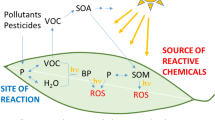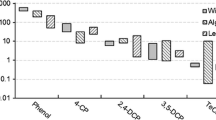Abstract
In a series of laboratory studies, a single 4-hr acidic fog at pH levels associated with commercial celery (Apium graveolens L.) production near major population centers in California was found to stimulate development of psoralen, bergapten, xanthotoxin, and isopimpinellin within 24 hr and for at least 120 hr after exposure. At 120 hr posttreatment, the concentrations of phototoxin furanocoumarins (psoralen + bergapten + xanthotoxin) increased 540% in the leaves (to 135 μg/g fresh weight) and 440% in the petioles (to 55.56 μg/g fresh weight) of celery exposed to a pH 2.0 fog as compared to plants exposed to control fogs (pH 6.3–6.5). Concentrations of these compounds in test plants were 7.5 times higher than the amount known to produce contact dermatitis. The nonphototoxic isopimpinellin increased more than threefold in the leaves (to 39.23 μg/g fresh weight, 120 hr) and petioles (to 25.88/gmg/g fresh weight) as compared to control plants. In contrast, a single ozone fumigation at 0.20 ppm for 2 hr generally reduced concentrations of phototoxin furanocoumarin in leaves of celery within 24 hr (ozone-treated plants = 37.9, controls = 69.5 μg/g fresh weight), but levels of these chemicals in leaves of ozone-fumigated plants increased rapidly and concentrations were not significantly different at 120 hr. Isopimpinellin concentrations in foliage followed a similar trend (at 24 hr, control = 25.11, ozone treated = 10.96/gmg/g fresh weight, no difference at 120 h). In petioles, none of the linear furanocoumarin levels differed significantly at 120 hr posttreatment.
Similar content being viewed by others
References
Ashwood-Smith, M.J., Poulton, G.A., Barker, M., andMildenberger, M. 1980. 5-Methoxypsoralen, an ingredient in several suntan preparations, has lethal, mutagenic and clastogenic properties.Nature 285:407–409.
Ashwood-Smith, M.J., Natarajan, A.T., andPoulton, G.A. 1982. Comparative photobiology of psoralens.J. Natl. Cancer Inst. 69:189–197.
Ashwood-Smith, M.J., Ceska, O., andChaudhary, S.K. 1985. Mechanism of photosensitivity reactions to diseased celery.Br. Med. J. 290:1249.
Austad, J., andKavli, G. 1983. Phototoxic dermatitis caused by celery infected bySclerotinia sclerotiorum.Contact Dermatitis 9:448–451.
Berenbaum, M. 1981a. Patterns of furanocoumarin production and insect herbivory in a population of wild parsnip (Pastinaca sativa L.).Oecologia (Berlin) 49:236–244.
Berenbaum, M. 1981b. Patterns of furanocoumarin distribution and insect herbivory in the Umbelliferae: Plant chemistry and community structure.Ecology 62:1254–1266.
Beier, R.C. 1985. A reverse phase technique for separating the linear furanocoumarins in celery.Liquid Chromatogr. 8:1923–1932.
Beier, R.C., andOertli, E.H. 1983. Psoralen and other linear furocoumarins as phytoalexins in celery.Phytochemistry 22:2595–2597.
Beier, R.C.,Ivie, G.W., andOertli, E.H. 1983a. Psoralens as phytoalexins in food plants of the family Umbelliferae, pp. 295–310,in Finley & Schwass (eds.). Xenobiotics in Foods and Feeds. ACS Symposium Series 234, Washington, D.C.
Beier, R.C., Ivie, G.W., Oertli, E.H., andHolt, D.L. 1983b. HPLC analysis of linear furocoumarins (psoralens) in healthy celery (Apium graveolens).Food Ckem. Toxicol. 21:163–165.
Berkley S.F., Hightower, A.W., Beier, R.C., Fleming, D.W., Brokopp, C.D., Ivie, G.W., andBroome, C.V. 1986. Dermatitis in grocery workers associated with high natural concentrations of furanocoumarins in celery.Ann. Intern. Med. 105:351–355.
Chaudhary, S.K., Ceska, O., Warrington, P.J., andAshwood-Smith, M.J. 1985. Increased furanocoumarin content of celery during storage.J. Agric. Food Chem. 33:1153–1157.
Chaudhary, S.K., Ceska, O., Tetu, C., Warrington, P.J., Ashwood-Smith, M.J., andPoulton, G.A. 1986. Oxypeucedanin, a major furocoumarin in parsley,Petroselinum crispum.Planta Med. 52:462–464.
Hoffman, M.R. 1984. Comment on acid fog.Environ. Sci. Technol. 18:61–64.
IARC. 1983. Monograph on the Evaluation of the Carcinogenic Risk of Chemical to Humans, Supplement 4: Chemicals, Industrial Processes and Industries Associated with Cancer in Humans. IARC, Lyon, France.
Igali, S., Bridges, B.A., Ashwood-Smith, M.J., andScott, B.R. 1970. IV. Photosensitization to near ultraviolet light by 8-methoxypsoralen.Mutat. Res. 9:21–30.
Ivey, L. andJohnson, H. 1986. Page 3,in Vegetable Crops: Acreage and Value at a Glance. U.C. Riverside, Cooperative Extension Publications.
Leung, S.K., Reed, W., andGeng, S. 1982. Estimations of ozone damage to selected crops grown in southern California.J. Air Pollut. Control Assoc. 32:160–164.
Munger, J.W., Jacob, D.J., Waldman, J.M., andHoffman, M.R. 1983. Fogwater chemistry in an urban atmosphere.J. Geophys. Res. 88:5109–5121.
Musselman, R.C., Sterrett, J.L., andGranett, A.L., 1985. A portable fogging apparatus for field or greenhouse use.Hortic. Sci. 20:1127–1129.
Scott, B.R., Pathak, M.A., andMohn, G.R. 1976. Molecular and genetic basis of furocoumarin reactions.Mutat. Res. 39:29–74.
Seligman, P.J., Mathias, C.G., O'Malley, M.A., Beier, R.C., Fehrs, L. J., Serril, W.S., andHalperIn, W.E. 1987. Photodermatitis from celery among grocery store workers.Arch. Dermatol. 123:1478–1482.
Shriner, D.S. 1986. Terrestrial ecosystems: wet deposition, pp. 365–388,in Legge and Krupa, (eds.). Air Pollutants and Their Effect on the Terrestrial Ecosystem. Wiley & Sons, New York.
Trumble, J.T., Hare, J.D., Musselman, R.C., andMcCool, P.M. 1987. Ozone-induced changes in host plant suitability: interactions ofKeferia lycopersicella andLycopersicon esculentum.J. Chem. Ecol. 13:203–218.
Waldman, J.M., Munger, J.W., Jacob, D.J., Flagen, R.C., Morgan, J.J., andHoffman, M.R. 1982. Chemical composition of acid fog.Science 218:677–680.
Zangerl, A.R. andBerenbaum, M.R. 1987. Furanocoumarins in wild parsnip: Effects of photosynthetically active radiation, ultraviolet light, and nutrients.Ecol. 68:516–520.
Author information
Authors and Affiliations
Rights and permissions
About this article
Cite this article
Dercks, W., Trumble, J. & Winter, C. Impact of atmospheric pollution on linear furanocoumarin content in celery. J Chem Ecol 16, 443–454 (1990). https://doi.org/10.1007/BF01021776
Received:
Accepted:
Issue Date:
DOI: https://doi.org/10.1007/BF01021776




